- Yokohama-shi Top Page
- Municipal Government Information
- Public Relations, Public Information, News
- Publications and publications
- Public Relations Printed Materials
- Public information Yokohama
- Public information Yokohama-shi version
- Discover Yokohama Aya
- "Yokohama Aya Discovery" series back number (2024)
Here's the text.
"Yokohama Aya Discovery" series back number (2024)
Last Updated November 1, 2024
Delivering back issues of "Public Relations Yokohama" serialized on the page
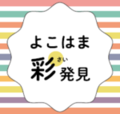
Yokohama with sea, port, greenery, history, region, people and various attractions. "Yokohama Aya Discovery" is a series of colors of this city. Since the January 2023 issue, it has been serialized on the "Public Relations Yokohama" page, and more detailed information has been posted on the website. Here, the past serialization of the paper (2024) is re-posted. In addition, please refer to the link in "More detailed stories" at the bottom right of each month article for the contents of the web.
November 2024 issue Showa Modern and a place to enjoy the changing seasons-The charm of the Matano Bettei Garden-
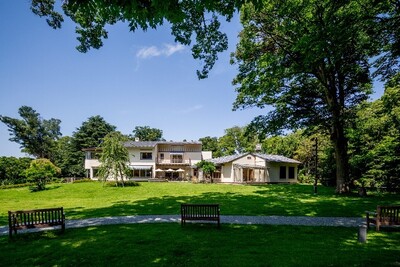
Green Garden and Matano Bettei ©BAUHAUSNEO
Emi Kuribayashi, director of Matano Bettei Garden
The Matano Bettei Garden is a scenic park characterized by terrain with height differences formed along the flow of the river.
The park consists of the inner garden, centered on the Matano Bettei, which is designated as a historic building certified by Yokohama City, and the outer garden ward, which is decorated with open lawn squares and various plants. On a clear day, you can see Mount Fuji and the Tanzawa Mountains.
Matano Bettei is a Japanese-Western eclectic house built in 1939 as the private residence of the 16th head of the Sumitomo family, and was once designated as a national important cultural property as a building under the influence of modernism in the early Showa era. Was. When it was rebuilt after being burned down by fire, preserved materials are also used, and the interiors such as doors and lighting fixtures that retain their original appearance are also highlights.
In Gaien Ward, you can enjoy the changing seasons such as cherry blossoms, azaleas, and autumn leaves, and you can hear the birds singing. In the garden tour "Garden Walk" with an exclusive guide, we introduce the charm of the garden and are well received every month.
You can spend a relaxing time while enjoying various expressions of the four seasons, such as concerts and tea time in coffee rooms. Matano Bettei Garden, where elaborate residential architecture and lush gardens are in harmony. Please come to the one-of-a-kind space where nature still remains even though it is an urban area.
Matano Bettei Garden (charged for visiting the house)
[Traffic] From Tozuka / Fujisawa Station, take the Kananaka Bus and get off at Teppo-juku, a 5-minute walk. There is also a parking lot (charged).
[Closed days] Third Thursday of every month (or the next weekday if it is a holiday), December 29-January 3
[Inquiry] Matano Bettei Garden Tel: 045-852-8038 Fax: 045-852-8048
October 2024 issue Yokohama streetcar preservation hall where you can immerse yourself in retro mood-New model diorama "Hama diorama" is born
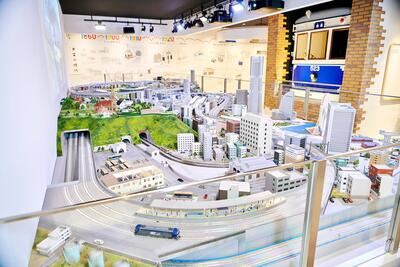
"Hama diorama" where you can enjoy three driving shows
Takao Muto, Director of the Yokohama Tram Preservation Museum
The history of the streetcar in Yokohama began 120 years ago. In 1904, Yokohama Electric Railway Co., Ltd. opened its doors between Kanagawa (now Yokohama Station) and Oebashi Bridge (now Sakuragicho-sta.). The fare was 3 yen, and the following year, a toll tax was added to finance the Russo-Japanese War, which was 4 yen. The price of udon and soba is 2 yen. Eventually, in 1921 (Daisho 10), about 100 years ago, the tram was municipalized, and the Yokohama City Electric Bureau was established in Takigashira, where the tram preservation hall is currently located. This is the birth of Yokohama tram.
The streetcar preservation hall opened in 1973 (Showa 48), the year after the streetcar was abolished, on the site of the streetcar factory in Takigami, Isogo-ku, and celebrated its 50th anniversary last year. As soon as you enter the inside of the streetcar displayed in the hall and sit in the seat, a time trip in the old days. You can immerse yourself in a nostalgic and retro mood. In addition, at the history exhibition corner on the theme of "Development and Transportation of Yokohama", you can see the history of Yokohama through maps, photographs, videos, and real exhibits.
And the recommendation is the model diorama "Hama diorama" which opened last July. Trains and buses run on a 9.5-meter-long diorama that imitates the city of Yokohama, and children and adults can enjoy driving shows that make full use of images, lighting, and sound. Why don't you come to the streetcar preservation hall where you can rediscover the news of Yokohama?
Yokohama tram preservation hall (charged)
[Traffic] Get off at the municipal bus "Shiden Preservation Museum" and walk 1 minute. Alternatively, get off at "Takigashira" and walk 3 minutes.
[Closed] Wednesday, Thursday (open on holidays), New Year's holidays
[Inquiry] Yokohama Tram Preservation Museum Tel: 045-754-8505 Fax: 045-754-8507
Special numbers hidden in the September 2024 issue stadium
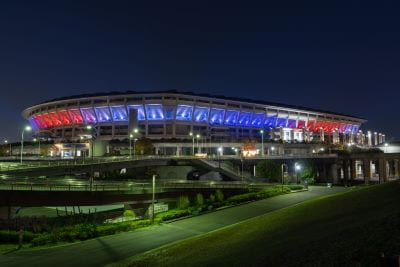
Stadium illuminated in tricolor color
Shin-Yokohama Park (Nissan Stadium) Designated Manager Representative Organization Yokohama City Sports Association Keita Kai
This year, the 26th anniversary of its opening, Nissan Stadium has a special number inherited by successive staff in charge of management and operation. 「3964」、「70103」、「8→9」、「23」。 These figures are related to the three major international competitions in which the finals took place at the stadium. The first "3964" was designed to encourage the Brazilian national team in the locker the day before the finals of the 2002 FIFA World Cup TM Japan-Korea Games.
This is the number used. The second "70103" is a special number that has not yet been broken, recorded between England and South Africa in the finals of the Rugby World Cup 2019 TM Japan Games. The third “8 → 9” is a very honorable change in schedule as the venue for the Tokyo 2020 Olympic Games soccer competition. For more information about what kind of numbers it is, please see the web version.
Also, the stadium has a variety of faces. The stadium is literally a general stadium, with a capacity of about 72,000, the largest in Japan. In addition to the use of sports in soccer, rugby, and athletics, we have supported many records and scenes that will be remembered by everyone, including concert performances by top artists. Many people may remember the dance performed in the field after participating in the Yokohama Municipal Elementary Schools Sports Festival.
On the other hand, the park including the stadium is the largest sports park in the city, and when there is a risk of flooding, the adjacent Tsurumi River is temporarily drawn in the river and stored on the premises to reduce flood damage to the basin. There is a Yu Suichi function to reduce. The fourth "23" is the number related to the Yusuichi function.
What memories do you have at Nissan Stadium (Shin-Yokohama Park)? If you have no connection yet, please come and create wonderful memories. We look forward to your visit!
[Inquiry] Nissan Stadium Tel: 045-477-5000 Fax: 045-477-5002
August 2024 issue "None beach" raised in Yokohama
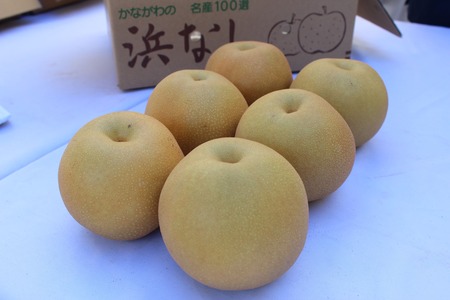
No beach (variety: Hosui)
There is no beach that has a reputation for being delicious ※ Do you know that? This is a general term for pears produced in Yokohama City, and pears that meet some conditions are certified. I've never seen it, where do you sell it? There may be a lot of people. It is sold directly at the farmhouse's garden and is rarely found in supermarkets and markets. This is because it is not suitable for general market distribution because the trees are lined up to the last minute and the best ripe timing of ripening is determined and harvested with the eyes of farmers.
It's not the only feature of fresh and fresh ripe pears, beachlessness. One ball is very good and big. In order to deliver more delicious pears to everyone, pear farmers gather and hold study sessions, and are working hard to improve their skills.
In Yokohama, the cultivation area of pears expanded in the 40s and 50s, and since then the main varieties were "Hosui" and "Kosui". It seems that it was in the latter half of the 1950s that the name recognition gradually increased, and the notation was unified in "Hama no Nashi".
In recent years, it has been difficult to grow pears due to global warming. Overcoming them, please enjoy the beaches that have been cultivated with great care this summer.
※No beach: Registered trademark of JA Yokohama
Holding Fair (Sales of Hamanashi and Hama Grape)
(1)Tuesday, August 20: JA Yokohama Nakazato Branch (2) Tuesday, September 3: In front of JA Yokohama "Hamakko" direct sales shop Minami store
[Sale time] <(1) and (2) common> Beachless spot sale starts at 10:00. Exhibits will be sold from 11:00 (numbered tickets will be distributed at the venue from 9:30). ※As soon as it is sold out, the stormy weather is canceled
[Inquiry] JA Yokohama (TEL 045-805-6612) or to the following
[Inquiry] Green Environment Bureau Agriculture Promotion Section Tel: 045-671-2637 Fax: 045-664-4425
July 2024 issue map shows the drastic change in Yokohama
Map Researcher Keisuke Imao
Forests and fields are conspicuous in the left figure of the 1968 revision, and the Sotetsu Izumino Line has not been opened. In the latest figure on the right, it is covered with vermilion showing the building, and it can be seen that the development has progressed.
When I was four years old, I moved from Hiratsuka to Minamikibogaoka, Hodogaya Ward (now Asahi Ward). It was in 1964 (Showa 39), when the Tokaido Shinkansen was opened. I was able to see the "Dream Super Express" from my home through the rice field. I remember that the Sotetsu Line, which passes through the nearest Kibogaoka Station, was certainly a few cars, and that a wooden yellow train was running.
At that time, Yokohama City was very rapidly increasing in population, and Makigahara Junior High School (A in the figure), which entered, had 14 classes in the first grade, and many prefabricated school buildings in the schoolyard. So I met a topographic map of 1/25,000. The social studies teacher showed me the real thing of "Western Yokohama" with the school, which triggered my current job.
I purchased the latest version of the 1968 Correction (left figure) at that time. I was looking forward to comparing it with the actual scenery while watching the arrangement of the buildings, tracks, contour lines, etc.
I imagined the local scenery by buying topographic maps not only in the vicinity but also in Hokkaido and Okinawa that I had never been to. More than half a century later, the figure on the right shows the drastic changes in the region. The old map is filled with "the air of the times."
Keisuke Imao (now Keisuke)
A map researcher. Born in Yokohama in 1959. I have been reading topographic maps and timetables since I was a junior high school student. Many books on maps, place names, and railways, such as "Map Mania Fancy Journey", "Japan 200 Years Map", and "Deep Reading Map of Map Books" series.
[Inquiry] Public Relations Section, Policy Management Bureau Tel: 045-671-2331 Fax: 045-661-2351
June 2024 issue The secret of Yokohama City Song 115, which seems to know and does not know
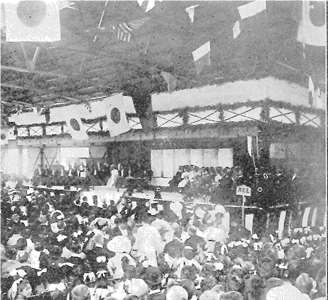
Celebration of the first city song "Yokohama Port Opening 50th Anniversary Commemorative Book" Narita Keinobu Municipal Central Library 1909
Yokohama City Song is a TV program that introduces the unique culture and customs of various parts of Japan, saying, "Everyone Yokohama citizen can sing?" It was created in 1909 (Meiji 42) to commemorate the 50th anniversary of Yokohama Port.
Lyrics are written by Bungo Mori Ougai (real name: 1862-1922), known for novels such as Maihime, and composed by Tokyo Music School (currently Tokyo University of the Arts) Assistant Professor Noe Minami ( (27 years old at the time of inauguration. 1881-1952). It was created using a technique called "T", in which the south wrote a song first, and then Ougai wrote the song accordingly.
The city song was unveiled at the celebration of the 50th anniversary of the opening of Yokohama Port on July 1. Conducted by Yokohama music educator Kiminosuke Takano, and performed by the Yokosuka Naval Band, sung highly by 300 elementary school student selected from elementary schools in the city.
In 1966 (Showa 41), the "Yokohama City Song Promotion Special Committee" shifted from the original song to the lower pitch, and partially repaired complicated pitches and rhythms, making it easier for citizens to sing. I made it easier.
After that, many cover songs and arrangement songs (jazz, blues version, Bon Odori, healthy exercises, etc.) were also created, and they were also incorporated into Yokohama DeNA Baystars support songs.
Even today, Yokohama Municipal Elementary Schools uses city songs as teaching materials to teach singing so that they can sing at elementary and junior high school entrance ceremonies and graduation ceremonies, and at the Dream of Harmony at the Yokohama Port Opening Festival, a 300-member citizen choir sings city songs as the first song on stage every year. Yokohama City Song, which has been loved by citizens for more than 100 years, wants to continue singing for a long time.
Reference: Municipal Central Library Web page "Book List: Reading and Knowing Yokohama City Songs" edited by Yokohama Symphony Orchestra "Yokohama Symphony Orchestra 150th Anniversary of Yokohama City Song 100 Years of Yokohama City Songs [Yokohama Yoraku Cultural History]
About the use of Utahara songs in Yokohama City The copyright of Utahara songs in Yokohama City has passed the protection period, so you can use them freely in principle.
[Inquiry] Board of Education Secretariat Lifelong Learning Cultural Properties Division Tel: 045-671-3282 Fax: 045-224-5863
May 2024 issue Noto Peninsula and Yokohama
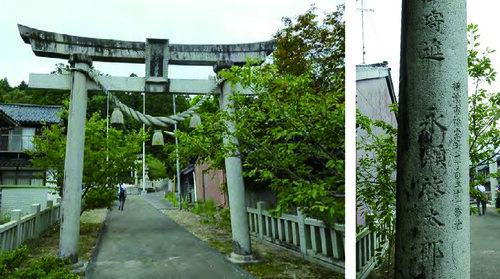
Enlarged photo of Notohi Shrine (left) and Torii (right)
Ritsuto Yoshida, Chief Researcher, Museum of Yokohama Urban History
On New Year's Day 2024 (Reiwa 6), a magnitude 7.6 earthquake centered on the tip of the Noto Peninsula occurred and the Hokuriku region was hit by a massive shaking. Not only did tsunami affected areas hit the coast, but also a large-scale fire broke out in the heart of Wajima City, some settlements were isolated by landslides and other means.
The Noto Peninsula is far from Yokohama, but there is a deep connection, for example, the Soto sect's large Motoyama So Mochidera in Tsurumi Ward originated in Mon, Wajima City. In addition, many of the roots of the people who run and support public baths in Yokohama City were located on the Noto Peninsula.
The shrines in Kashima-gun, Hakui-gun, and Nanao-shi in Ishikawa Prefecture have many torii gates, komainu, and lanterns engraved with the word "Yokohama". For example, are Keitaro Noto (1-chome Noto Hime Shrine in Nakano-cho, Kashima-gun, which was built in 1923 (Daisho 12). Nagase is a wholesaler dealing with glass products used in public baths, and his relatives also ran a public bath in Yokohama. The successful public bath manager in Yokohama actively donated money as a return to his hometown, and there was a flow in which people who saw it moved to Yokohama. The public health of Yokohama citizens was supported by people from Noto Peninsula.
Since the opening of the port in 1859 (Ansei 6), the land of Yokohama has built a community by accepting immigrants from various countries and regions. Let's think about the connection between Noto and Yokohama, support and support the reconstruction of Noto from Yokohama.
[Inquiry] Public Relations Section, Policy Management Bureau Tel: 045-671-2331 Fax: 045-661-2351
April 2024 issue Expectations for the new Yokohama-bijutsukan
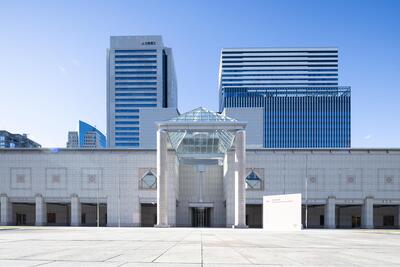
Yokohama-bijutsukan exterior (pictured by Kenshu Shintsubo)
Yokohama-bijutsukan Deputy Director and Chief Curator Tomoo Kashiwagi
Do you remember the Yokohama Exposition held in 1989? Yokohama-bijutsukan was unveiled as one of the pavilions of this exposition and officially opened in November of the same year.
From the concept stage, there were five philosophies of Yokohama-bijutsukan, a place for international art exchange, a place for appreciation and creation, an art information center, a collection of photographs, and the development and development of citizens' art activities. On the right side, the art museum was opened by Kenzo Tange, one of Japan's leading architects.
The museum, which has been watching the development of the Minato Mirai 21 district, has been closed for large-scale renovation since 2021, after 30 years of opening, but was completed in November last year. Currently, it is the venue for the 8th Yokohama Triennale, and we are also conducting projects that anyone can enjoy, such as "Children's Art Plaza" Harappa "".
The new Yokohama-bijutsukan art library will be relocated and you will be able to enter and exit directly from Bijutsuno-hiroba in Grand Mall Park. There will be a new gallery in front of the library, shops and cafes will be newly opened, and the atelier will be upgraded to provide more and more space for everyone.
Yokohama-bijutsukan
"The 8th Yokohama Triennale is being held until Sunday, June 9th.
[Traffic] Get off at Minatomirai Station in Minato Mirai Line, a 3-minute walk or get off at Sakuragicho Station on the JR Negishi Line Municipal Subway Blue Line.
[Inquiry] Yokohama-bijutsukan Tel: 045-221-0300 Fax: 045-221-0317
March 2024 issue Secrets of Chinatown and Glossary
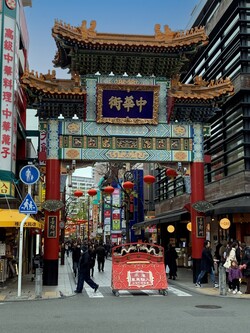
Yokohama-Chinatown (get off at Motomachi-Chukagai Station on Minato Mirai Line)
Writer Yoko Yamazaki
I was asked by a friend from a distance to say, "I will guide you to the" Yokohama "that you want to boast the most," and decided on Chinatown without hesitation. Look like Yokohama street, go to such a natural sightseeing spot? It seems to be said, but no, I want to show you not only delicious food and Asian miscellaneous goods. I want you to know the origin of this town and enjoy a more tasty moment.
At the end of the Tokugawa period, Japan opened the country after breaking the long isolation. The simple Yokohamamura was selected as the gateway, and foreign people, goods, and culture landed with an avalanche. It was transformed into an international city. But the problem is communication. The language barrier is big.
So, the Chinese who initially traveled to Japan as an employee of Westerners. Japan has a common language called "Kanji". In addition, they have a way of life called "an overseas Chinese." I was born in China, but I call those who go abroad and take root in it. They are familiar with both the Orient and the West. It wasn't just an interpreter. From the rules of overseas trade to advanced industrial technology in the West, the Japanese are taught. It became an indispensable presence in both Western countries and Japan, and the number of people increased.
The overseas Chinese make their own residential area in the country where they have taken root. That's Chinatown. My Yokohama-Chinatown is known as the most gorgeous Chinatown in the world. However, looking back on history, it was never a peaceful step. During the Sino-Japanese War and the Sino-Japanese War, he was forced to live in the middle of an enemy country. But the lights of this city did not turn off. On the contrary, it's more radiant. No matter what, we love this city.
In fact, there is a scene of history that is not surprisingly known. In 1872, a major incident that shakes the international community, not just between Japan and China, broke out in Yokohama. For more details, please see the 2D code in the upper right corner.
Yoko Yamazaki (Yoko Yamazaki)
Born in Kyoto Prefecture in 1947 and lives in Yokohama City. Received the 32nd Edogawa Ranpo Award. Many works set in Yokohama, such as "Yokohama Port Opening Emaki Red Cliff Woman", "Yokohama Tangjin Okichi Jimon", and "Angel sings Blues".
[Inquiry] Policy Bureau Public Relations Section Tel: 671-2331 Fax: 661-2351
February 2024 issue of Yokohama Export Crafts
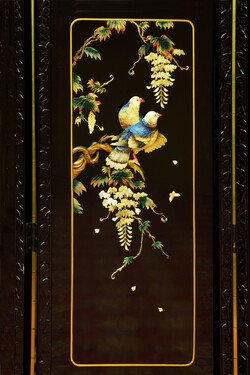
Yokohama Shibayama Lacquerware "Flower and Bird Screen" (partial) Yokohama City Museum of History
Koichiro Kobayashi, curator of the Yokohama City Museum of History
In Yokohama, with the opening of the port at the end of the Tokugawa period, literally "opening the port" began trade with overseas, and many crafts and artworks were exported from Japan. After that, as exports of crafts and other crafts increased, crafts such as shapes and patterns that match the tastes of Westerners began to be produced, and production began in Yokohama, which saves the trouble of transportation.
In this exhibition, we will focus on four types of export crafts, including Yokohama Shinkatsu ware, Yokohama Shibayama lacquerware, Yokohama Sculpture Furniture, and Yokohama Export Scarves, and outline a part of its history. Yokohama Shibayama lacquerware, which has influenced Western ceramics products as "Makuzu ware", and Yokohama Shibayama lacquerware, which is decorated with relief such as "Shibayama inlaying", and sculpture techniques found in shrines and temples, are used not only in exports but also in foreign residences living in Yokohama, and about 60% of the world's scarf production.
It is a valuable opportunity to see these materials bearing Yokohama in one hall. I hope you will feel the beauty and design of each material, such as the charm that is connected to the world.
[Inquiry] Yokohama City Museum of History Tel: 912-7777 Fax: 912-7781
January 2024 issue of Yokohama Fire Department History and Music Band-Towards a Bright Future
Yokohama Disaster Risk Reduction Learning Center (in charge of firefighting music band) Yoshinori Nagamine
One of the New Year's traditions, the first ceremony, which is also a seasonal word for haiku. The Yokohama Fire Fighting First Ceremony 2024 will be held on Sunday, January 7, and this year we will show the firefighting and disaster response capabilities of Yokohama Fire Fighting. The history of the Yokohama Fire Department began with the formation of a private fire department at the same time as the opening of Yokohama Port in 1859 (Ansei 6), and the first ceremony was held the following year. Yokohama is considered the birthplace of modern firefighting, with steam fire pumps imported from U.K. being deployed in 1871 (Meji 4). Yokohama firefighting is always at the forefront of the times, with Japan's first fire engine in 1914 (Daisho 3) and Japan's first ambulance as a fire engine in 1933 (Showa 8).・ I have been protecting security. The Yokohama City Fire Music Band plays a role in communicating the activities of the Yokohama Fire Department to everyone.
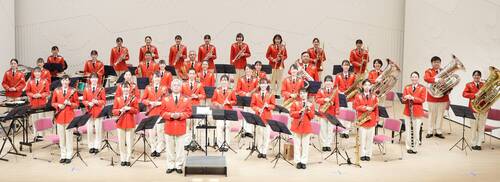
Founded in 1958 (Showa 33) to commemorate the 100th anniversary of the opening of Yokohama and the 70th anniversary of municipal administration, the firefighting music band conducts disaster prevention awareness activities through performances and performances in various parts of the city, as well as the Yokohama Port Opening Memorial Minato Festival `` The Yokohama Parade '', welcome ceremony for large passenger ships entering the port, and performances and performances that have been practiced at the Yokohama Marathon. In addition, we are focusing on next-generation upbringing programs to foster children's creativity and develop cultural arts, such as conducting musical instrument guidance workshops for junior high school students in the city.
On Saturday, March 16th, we will hold a concert commemorating the 65th anniversary of the foundation with the theme of "Leap-To a bright future" with appreciation for the support of everyone so far. We will show a brilliant figure, including the announcement of the new parade clothes of the fire brigade drill team "Port Angels 119", which was launched in 1982 (Showa 57). We are looking forward to seeing you all.
[Inquiry] Yokohama Disaster Risk Reduction Learning Center Tel: 312-0119 Fax: 312-0386
Inquiries to this page
Public Relations Section, City Promotion Promotion Office, Policy Management Bureau
Telephone: 045-671-2331
Telephone: 045-671-2331
Fax: 045-661-2351
Email address: ss-koho@city.yokohama.lg.jp
Page ID: 637-622-071







